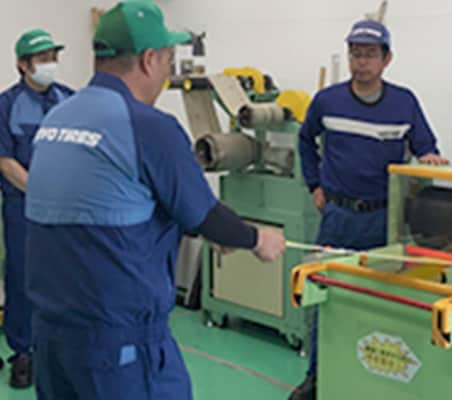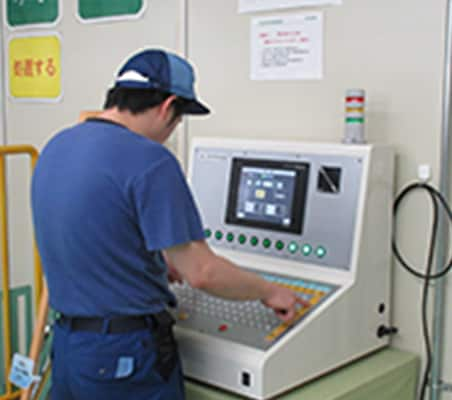Creating Safe Workplaces
Creating Safe Workplaces
We are working to create safe workplaces from the three perspectives of “equipment,” “personnel,” and “management system development” at all business sites.
With regard to physical aspects, by conducting a risk assessment on the hazards, we promote the elimination of hazards based on safety standards for equipment and safety measures such as an enclosure or interlock.
From the aspect of "personnel," we strive to visualize the "residual risks" that remain after an action has been taken for equipment. In more concrete terms, we thoroughly manage such risks by pinpointing high residual risks, establishing work standards, taking "stop, call, and wait" approaches, and promoting "point and call" and hazard prediction (KY in Japanese) activities and small-group activities (voluntary improvement activities by small groups). Furthermore, each business site provides a training program in accordance with the stratified safety training scheme, with an emphasis on "KY" training and experiential safety training. To provide employees with such experiences, we set up Safety KY Training Halls. Here, we use special machines to give a realistic sense of equipment hazards and draw attention to the importance of working by the rules. By the end of 2020, we established training halls at seven locations. At production facilities where employees with diverse backgrounds work, we make announcements in multiple languages and use illustrations and color-coded warnings signs.
To eradicate disasters resulting from human errors, we will change behaviors by continuing to work on activities designed to raise and maintain people's awareness while also organizing risk reduction activities.
As for the creation of a management system, we are expanding industrial health and safety management systems, including OSHMS, GSC, and OHSAS 18001. We have compiled the Industrial Accident Response Manual with the aim of protecting employees' safety and the company's credibility by taking prompt and adequate responses when labor-related accidents occur to prevent damage from spreading, thus keeping personal and physical losses to a minimum.
Stipulated clearly in this manual are concrete steps to follow when an industrial accident occurs, a necessary risk management system against industrial accidents, procedures in ordinary times, the code of conduct for employees, and procedures in the times of emergency.
In Japan, persons in charge of safety and disaster management and the Environment & Health Department at all sites meet monthly (currently online). By using these opportunities to provide information on what they do to prevent and mitigate disasters, they share best practices across all sites to prevent similar disasters from occurring at other sites.
As a result of these efforts, in fiscal 2020, our total incidence rate of occupational accidents in Japan decreased by 28% from the previous year.
We also care about the safety and hygiene management of those who engage in our operations through means and methods that are under management of the Toyo Tire Group at manufacturing bases in Japan although they are not employed by the Group (hereinafter, “non-regular workers”) by, for example, distributing the “On-site Safety Training Textbook” to non-regular workers.
FY2020 Safety Performance
- The lost-time accident rate (Manufacturing base) *Number of lost-time accidents per million hours worked in total
In Japan: 0.14 (0.00 in FY2019)
Outside Japan: 1.69 (1.82 in FY2019)
Average of rubber product manufacture in Japan: 0.71
Enhancing Safety Training Program
In addition to “stop, call, and wait” (TYM in Japanese) activities and point & call checks, we are vigorously promoting hazard prediction (KY in Japanese) activities so that they will take root throughout the organization as small group-based voluntary efforts.
Each of our business sites conducts safety training in line with the grade-specific safety education system. Our safety training focuses on “KY” training and hands-on education. We are moving forward with establishing “Safety KY Training Halls”, where employees learn the importance of conducting work in line with rules by experiencing the dangers that machinery entails through hands-on educational equipment. As a of FY2020, there are 7 sites in domestic and oversea facilities.
we have been working to further enhance safety education programs. In addition to analyzing trends in accidents at each business site based on the data of past accidents and minor incidents and developing and implementing effective measures and training programs, we are strengthening the education of certified troubleshooters. For equipment planning and design departments, we started a Safety Assessor* training program to develop certified safety assessors, and as of FY2020, 290 people have been certified as safety assessors.
- *Employees who possess the knowledge and skills needed to evaluate the safety of machinery and the overall ability to judge its appropriateness.
| Safety Basic-Accessor (SBA) | : | Can Operate Equipment Safely |
|---|---|---|
| Safety Sub-Assessor (SSA) | : | Can assess risks based on fundamental knowledge and skills concerning the safety of machines |
| Safety Assessor (SA) | : | Can draw up safety measures by conducting risk assessments based on knowledge and skills concerning the safety of machines |
| Safety Senior Assessor (SEA) | : | In addition to the competence of SAs, can perform from design to verification on certain safety technology fields |
| Safety Lead Assessor (SLA) | : | In addition to the competence of SAs, can validate machines in an integrated manner from a third-party's perspective based on relevant expert knowledge |
*Reference: Japan Certification Corporation
Sustainability
- Message from the President
- TOYO TIRE Value creation
- TOYO TIRE Sustainability
-
TOYO TIRE Materiality
- Help create a society of sustainable mobility / Support the enjoyment of mobility for all
- Support diverse talent with motivating challenges and job satisfaction
- Continue innovating next-generation mobility technology
- Pursue decarbonization in all corporate activities
- Promote supply chain sustainability
- Ensure the fundamentals of manufacturing: quality and safety
-
ESG Activities
- E: Environment
- S: Upholding human rights
- S: Managing occupational health and safety to global standards
- S: Crisis management (responding resiliently to natural disasters, infections and other crises)
- S: Working with local communities (Helping solve local issues)
- G: Sound governance
- G: Compliance
- G: Risk management
- G: Information security
- G: Promoting digital transformation (borderless and centralized business management through ERP reform)
- External Recognition
- Report Library
- ESG Data
- ESG Data/Survey Index
- GRI Content Index
- Communication on Progress (CoP) Index
- Editorial Policy



